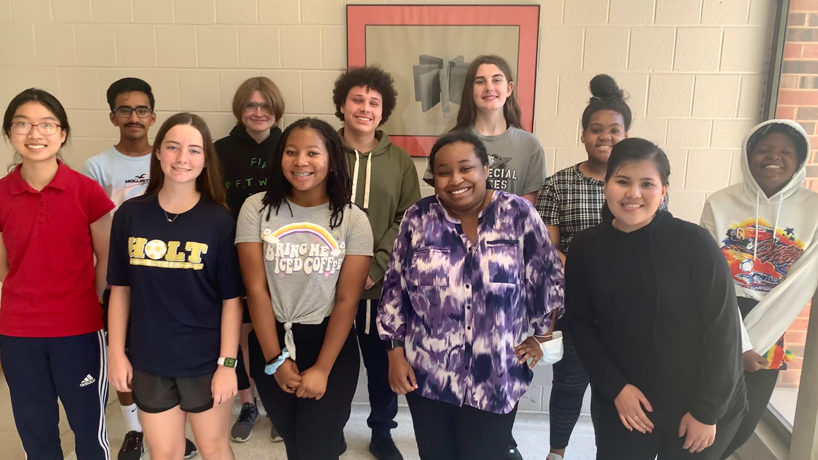
The OneCity Stories program is sponsored by UMSL’s Gateway Writing Project and brought together 11 high school students from across the St. Louis region to hone their writing and multimedia skills. The three-week program provided tutelage in disciplines such as fiction, lyric, opinion and poetry writing; filmmaking; podcasting; and storytelling. (Photo courtesy of Diana Hammond)
Quentin Alimayu paced a classroom in Clark Hall at the University of Missouri–St. Louis in bouts of excitement.
He eagerly explained the role music plays in social change and social justice to a group of 11 high school students from across the St. Louis region.
“Music can be powerful,” said Alimayu, a middle school history teacher in the Ladue School District. “It can be joyful, but sometimes music can teach you about cultural identity. It can relate to historical and contemporary events, and that is power – power between music and life in general.”
Indeed, the far-ranging discussion touched on topics such as The Chicks’ – formerly The Dixie Chicks – opposition to the Iraq War, differences in lived experiences, the origins of protest music, policing in the U.S. and even Nat Turner’s Rebellion.
Alimayu ended his lively presentation with a project for the students. They were tasked with thinking about music as action and had a choice of three projects for the day: take a contemporary song and rewrite the lyrics to address a current issue, analyze a socially conscious song from a previous decade or write an original song to address an issue important to the student.
The session was part of the OneCity Stories program sponsored by the Gateway Writing Project at UMSL. OneCity Stories brings together St. Louis-area high schoolers from across the socioeconomic and geographic spectrum to hone their writing and multimedia skills and is aimed at breaking down divisions in the city.
“If we can get people in a room together that have very different experiences, the barriers that society constructs for us – the physical barriers we have – we can eliminate some of those and form a supportive community for the kids to write and learn about each other,” OneCity Stories Director Diana Hammond said.
The three-week program provides tutelage in disciplines such as fiction, lyric, opinion and poetry writing; filmmaking; podcasting; and storytelling. The participating students were selected through an application process that included writing samples.
In previous years, each week of the program explored a specific medium of journalistic storytelling. However, after returning from a two-year hiatus due to the COVID-19 pandemic, Hammond decided to shift the program toward a looser structure more aligned with the students’ interests.
“What we were seeing the kids really wanted out of the program was not necessarily those expressly journalistic skills so much as space and opportunity to write different genres,” she explained. “This year, we designed it by talking about words first, then thinking about adding images to those words and then building in sound. You could really take one piece, and it could look different in many forms, become different things. But that all is rooted in the writing first.”
She added that this year’s program employs an activist lens with the intent to show students their voices can lead to change.
From June 13 to July 1, Alimayu, Hammond and program leaders Cathy Griner and Randy Meyer guided students through mediums including activist poetry, editorial cartoons, infographics, place-based writing, podcasts, protest music, scripts, slam poetry, snapshot biographies, speculative fiction and vision boards.
Hammond said the idea was to give students many entry points to stimulate their creativity, with the goal of producing three pieces of refined work by the end of the program. The students shared their final products via a digital portfolio.
Throughout the three weeks, a variety of special guests spoke with the students, too. The team worked to assemble a “round table” of people using their voice to effect change. That group included changemakers such as Khalea Edwards, an activist and political consultant, who helped found Occupy City Hall STL, advocated for the unhoused and protested Line 3 in Minnesota.
“We had a couple of people who have run for political office,” Griner said. “Then we also had a priest who broke away from the Catholic Church.”
The students also went on a field trip to the Missouri History Museum in Forest Park to visit the St. Louis Sound exhibit.
Taariq Ahmed, a rising sophomore at Ladue Horton Watkins High School, said being part of a community of enthusiastic writers improved his writing greatly over the course of three weeks. At Ladue, Ahmed enjoys writing for his English and journalism classes, and he contributes to a political blog outside of school.
However, OneCity Stories exposed him to new forms or writing and broadened his perspective on many issues.
“I think my experience has been really, really good,” he said. “I think I’ve learned to think differently and to see what it’s like for people who don’t live in areas like I do. I’ve met a lot of people from different backgrounds in different areas of St. Louis. It’s really been eye-opening. Mr. A got us to think about social justice in a different way than I’m used to. So, he’s exposed me to a lot of different genres and mediums to express how I feel.”
Hammond said it was a joy to watch the high schoolers return to UMSL and bond with each other.
“The older kids in high school had a really hard time during the pandemic,” she said. “I think that some of them forgot how much they valued and enjoyed being in physical company with each other. I think kids have forgotten the value of coming out in the world. So, it’s just been really nice to see them warm up to each other.”














